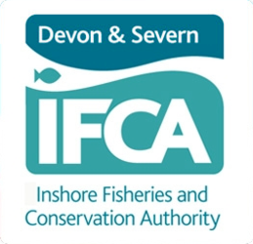FRMP Documents
- Home
- Environment & Research
- Fisheries Research & Management Plans
- FRMP Documents
Page review/updated 04/12/2024
(Content of page last updated: 4th July 2022)
Devon and Severn Inshore Fisheries and Conservation Authority (D&S IFCA) and the North Devon Biosphere have produced a series of innovative Fisheries Research Management Plans (FRMPs) for five commercially important species in the north of D&S IFCA’s District: herring, bass, skates and rays, whelk, and squid. In addition to each species-specific FRMP, a shorter summary document has been produced summarising the research and management recommendations for each species. FRMPs focusing on these species in the south of D&S IFCAs District are currently being developed, as well as FRMPs for additional species.
THE FULL FRMPS

Please use the links below to view the full FRMPs.
THE FRMP SUMMARY DOCUMENTS

Please use the links below to view the FRMP summary documents.
The FRMPs use existing information and engagement with the local fishing industry to investigate whether a localised, ecosystem-based approach to management is possible and beneficial for each species. Each plan makes a series of research and management recommendations that need to be addressed to facilitate a transition to the most appropriate management approach for the fishery. A selection of key points has been summarised here, though more information is available in the summaries and full FRMPs.
BASS
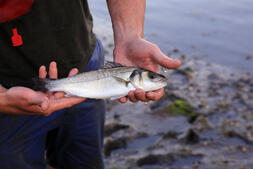
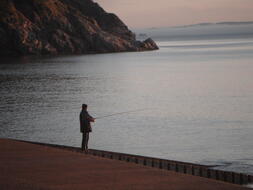
European sea bass remains one of the most challenging species for fisheries managers, due to its popularity with both commercial and recreational fishers. Bass stocks have been subject to heavy fishing pressure in the past, leading to large population declines. Therefore, a range of restrictive measures were introduced to help stocks recover, including the designation and protection of various nursery areas for bass around the UK – including several in the Bristol Channel. Research shows that the Bristol Channel is used regularly by bass with many individuals spending as much as 80% of their time there.
Fisheries – European sea bass is a high-value species that is popular with both commercial and recreational fishers/anglers. Bass is also an important aquaculture species, particularly in the Mediterranean. Commercial fisheries began in the 1970s and expanded throughout the 80s and 90s. Strict management was implemented in the 90s and more recently to prevent overexploitation, however a TAC (total allowable catch) has still not been set for the species.
Sustainability – European sea bass populations in the Atlantic have been in decline since 2009 and are now at their lowest in history. The rate that the stocks reproduce has also declined. In 2015 the EU implemented strict emergency measures to prevent the stock collapsing. Currently, the regulations over recreational and commercial fisheries care reviewed on an annual basis depending on health of stock. Local fishers have described the bass regulations as disgraceful and argue their small-scale fishing has a negligible effect on stocks.
Threats – One of the most significant threats to sea bass historically has been overfishing enabled by a lack of restrictive management, particularly the absence of agreement on TACs. Coastal developments in the Bristol Channel could have an impact on the use of surrounding areas as nursery grounds. Illegal and unreported netting for bass can be a big problem in the Bristol Channel and fishers have reported the need for a stronger enforcement presence from the IFCA.
Recommendations – Catch recording data for commercial and recreational fisheries needs to be improved to inform management, especially on a local level. Any changes in management need to affect both recreational and commercial sectors proportionately to their impacts. Additional research is needed to get a more detailed understanding of bass stock structure in Bristol Channel to see if current management is at the appropriate scale.
HERRING
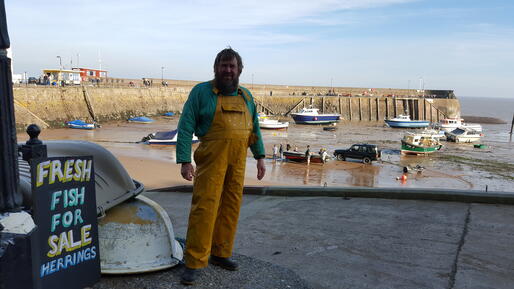
The various species of herring form some of the largest and most important commercial fisheries in the world, This FRMP focuses on Atlantic herring. The Atlantic herring is found all around the UK and the North Atlantic. A recent project has found that herring are spawning locally in the Bristol Channel and that these small stocks are genetically different to herring found in the Celtic Sea. Herring are forage fish which makes them an important part of the coastal food web supporting many organisms.
Fisheries – There are large commercial fisheries for herring in the North and Celtic Seas. The Bristol Channel is famous for its historic herring fisheries but today the fishing is small-scale and artisanal with only several commercial fishers operating using traditional netting. However, the species still holds significant cultural importance to these coastal communities.
Sustainability – Historically, stocks around the UK have fluctuated dramatically. There have been several large stock crashes which has led to the implementation of stock rebuilding plans by the EU.
Threats – There are concerns about developments and aggregate extraction activity in the Bristol Channel e.g., Hinkley Point C and the impacts this may have on local herring stocks and their spawning grounds. Changing consumer tastes in recent decades has led to declines in the market for herring, and the decline in numbers of active herring fishers.
Opportunities – There are several research opportunities to build on knowledge of stock structure gained through the Bristol Channel Herring Project. There are also opportunities to develop the market for herring, including by creating a local smokery and developing a sustainability/ local provenance label that reflects the nature of this artisanal fishery.
Recommendations – It is Important to continue research to identify local herring stocks and their spawning grounds so that they can be protected. There is an opportunity for collaborative research to see if and how different herring stocks mix in the Celtic Sea. The findings would inform management and support a move to more local management of herring stocks. Current management measures cover large ICES areas, ignoring the fine-scale population structure of fish stocks that would be effectively addressed with a more localised approach, representing stocks at a more appropriate scale.
SKATES & RAYS
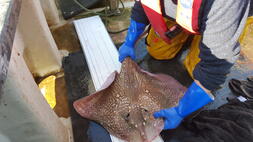
Several species of skate are caught regularly in the Bristol Channel, most landings comprising of blonde, thornback, spotted, cuckoo and small-eyed rays. All these species are found around the UK apart from the small-eyed ray, which is not found further north than the Celtic Sea. Fishers have reported that there are fish spawning and nursery grounds off Minehead that are used by a variety of species, including large numbers of egg-bearing and juvenile skates.
Fisheries – Skates and rays are a key commercial fishery in the UK; the annual value of Bristol Channel skate landings alone reaches £1 million in some years. They are popular with commercial and recreational fishers and are mostly caught in trawls and nets. The small-eyed ray is extremely important for supporting local Channel fisheries, and 70% of UK landings of this species come from the Bristol Channel.
Sustainability – There is very littlehistorical data on specific skate species, but landings have decreased steadily from the 1960s and are now only a fraction of what they were previously. Commercial and recreational fishers within the Bristol Channel have noticed a decline in numbers in skates and rays over the last few decades. Measures previously set by the EU had banned the landing of small-eyed in the Bristol Channel, but local fishers worked with Defra to overturn this and instead set a TAC (total allowable catch).
In the past the management was not species specific but that is beginning to change. There are now various restrictions and TACs in place for individual species across Europe. The North Devon Fisherman’s Association has also put in place a series of voluntary measures in the Bristol Channel to preserve local skate stocks.
Threats – Skates and Rays are vulnerable to overfishing as they are slow growing and late-maturing. Because of their shape they get caught in most fishing gears and this causes issues with bycatch and discards, especially in trawling fisheries. They are vulnerable to developments and aggregate extraction in the Severn, for example, Hinkley Point C is predicted to cause significant mortality of thornback ray in the area.
Recommendations – The management and assessment of skates and rays needs to be species specific to ensure that stocks are assessed and managed sustainably at the appropriate scale. Research is needed to help shed light on skate species distribution and use of habitat in the Bristol Channel to achieve this and inform management. This is particularly important for small-eyed rays which are a key species for local fisheries. Research is needed to confirm and locate spawning and nursery grounds off Minehead, as reported by local fishers, to enable protection of this essential fish habitat.
SQUID
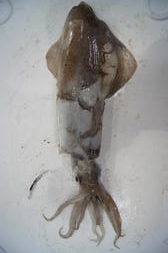
There are two main groups of squid found in UK waters – long finned and short finned. The most-fished squid are the veined and European long-finned species. All squid species have a ‘live fast, die young’ life cycle, with lifespans rarely lasting more than a year. Squid are an important food source for a variety of marine life, so are a key part of the marine food web.
Fisheries – Squid fisheries are expanding in the UK and around the world. Targeted squid fisheries operate in the west of Scotland, and in several areas in the south west of England, including the Bristol Channel, with the rest of the squid landings from the UK being caught as bycatch. The Bristol Channel used to provide a reliable squid fishery; however, squid all but disappeared from the region around 10–15 years ago. Fishers think this is a result of increasing populations of spurdog feeding on squid. Populations of spurdog have been increasing over the past decade following an EU fishing ban. Squid are not often targeted by recreational fishers, but they are a popular source of bait for anglers.
Sustainability – Currently there is no assessment or monitoring of squid and fisheries are almost completely unregulated. This could cause problems for the species in the future if the decline of finfish fisheries causes squid fisheries to expand without appropriate management. Sea temperature rise through climate change is expected to increase populations and expand the geographic range of squid.
Threats – Unregulated fisheries could make squid vulnerable to overfishing if fisheries continue to expand without management and monitoring in place. The “live fast, die young” nature of squid makes them a difficult fishery to manage, as populations can naturally fluctuate dramatically, even without exploitation.
Recommendations – Research is needed on the stocks and distribution of squid species to inform future management options. A best-practice framework should be developed for UK squid fisheries to ensure sustainable exploitation in the future. A precautionary approach should be used until this data and information is available. There is a specific research opportunity on the decline of squid in the Bristol Channel and the recovery of spurdog.
WHELK
Whelk are marine gastropods that are found just below the tidal zone around the UK coastline. There are two distinct sexes, and their breeding season is different depending on their location. The breeding season in Europe is normally autumn to the middle of winter.
Fisheries – Whelk fisheries have been expanding since the 1970s. Whelk is a non-quota species, meaning they provide an alternative catch to more traditionally fished species. Approximately 20,000 tonnes are landed annually by the UK fleet, with the majority being exported to Asian markets.
Sustainability – Whelk is anon-quota species that has been subject to overfishing with destructive gear, which led to previous stock collapses in the Irish and Wadden Seas. There is currently little management in place at EU level other than a minimum conservation reference size (MCRS) of 45mm. Research is suggesting that having a universal MCRS is not an effective way of protecting most whelk stocks, as different populations mature at different sizes. Some IFCAs have set regional MCRSs to address this. For example, the MCRS in the D&S IFCA district has been increased gradually to 65mm, reflecting the size of maturity in the Bristol Channel area.
Threats – Whelk are vulnerable to overfishing unless further management is put in place to limit fishing levels.
Opportunities – North Devon fishers are open to a trial in reducing the amount of fishing taking place by using a potting limit or limiting the days at sea. The potting limit is the safer option but limiting the days at sea would help restore “seasonal fishing.”
Recommendations – It is essential to carefully control fishing effort for whelk to prevent future stock collapses. Policymakers will need to work closely with the fishing industry to achieve this. Research is needed to identify the size of maturity for all whelk fisheries to ensure the relevant MCRS is effectively protecting the stock.
